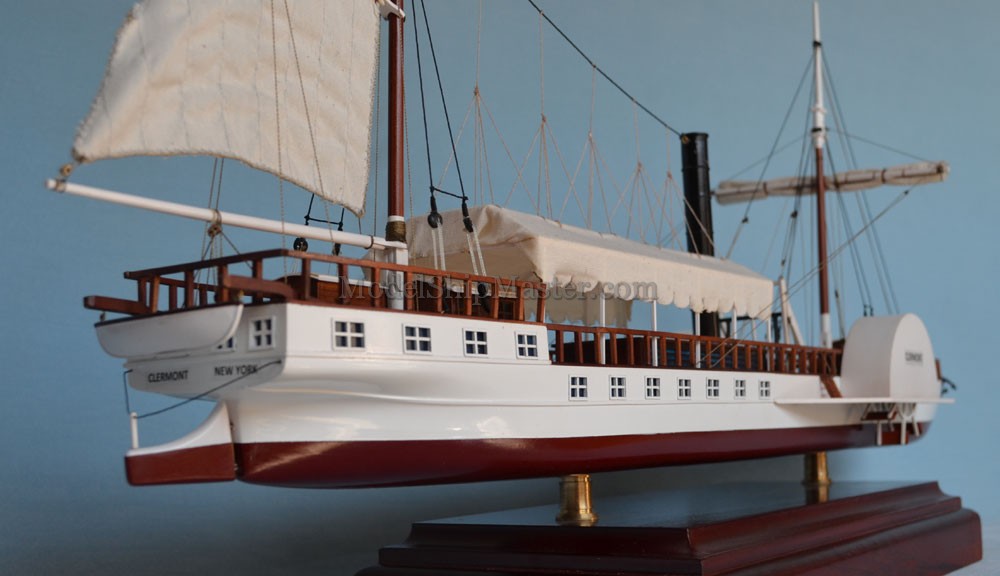|


256-bit encryption
$500,000 protection

|
CLERMONT 1808
Robert Fulton's Steamboat
.jpg)
Painter, inventor, and
engineer, Robert Fulton was a man of many talents.
Fulton achieved his place in history by producing
the first commercially successful steamboat.
His success raised the curtain for the
commercial development of America's waterways,
particularly the Ohio and the Mississippi.
In 1802 Fulton contracted with Robert Livingstone,
the United States minister to France,
to
build a steamboat that would ply the Hudson River. Livingstone held the rights for steamboat navigation
on the waterway.
Fulton
directed the construction of the steamboat in New York
in 1807. Registered as the North River Steam Boat, the
ship was called the Clermont. Fulton didn’t invent
the steamship, but in the Clermont, he built a sturdy
boat with a durable engine--one
strong enough to become a commercial success. By
hiding the boiler and engine, adding awnings and cabins,
Fulton made steamship travel acceptable to the swells.
.jpg)
On the
afternoon of Monday August 17, the Clermont steamboat was moored on
the East River off Greenwich Village. Aboard were
Fulton, Livingston and numerous adventurous friends
eager to make the historic voyage. The Clermont boat was an
odd looking craft 150 feet long and 13 feet wide.
Amidships was her engine, a steam boiler that belched
flame and smoke as it powered two paddle wheels placed
on either side of the hull. From the shoreline of
the Hudson River, spectators witnessed a shocking sight. There
in the river was a mechanical monster spewing flames and
smoke. It was 'Mr. Fulton's Folly'!
Most of the people all thought the steam thingy would
blow up and explode to the high heavens or roll over
like a log that would sink fast.
At one o'clock Fulton cast off and began his journey
into history. Trouble reared its head almost
immediately as the ship's engine stopped shortly after
leaving the dock. “I heard a number of sarcastic
remarks,” Fulton later wrote. “This is the way in
which ignorant men compliment what they call
philosophers and projectors.” Fulton rolled up his
sleeves and—missing out on the opportunity to invent the
word “glitch”—soon rectified “a slight maladjustment of
some of the work,” and off the needle-like vessel went,
clanking and hissing, every bit a monster.
Twenty-four hours and 110 miles later, the Clermont
steamboat stopped at
Livingston’s estate, from which the boat takes its
popular name, the Clermont. The next day it
ventured on to Albany, having finished in about a day
and a half a trip that took the better part of a week by
sloop. “We saw the inhabitants collect; they waved their
handkerchiefs and hurrahed for Fulton,” wrote one
passenger, the French botanist François André Michaux.
So the Clermont made her first successful trip 150 miles
up the Hudson River from New York City to Albany, in
about 30 hours, including an overnight stop.
Clermont was not the first steamboat to be built, but it
was the very first to become a practical, financial, and
commercially successful steamboat. Part of
Fulton's success was due to his concern for passenger
comfort. His handbills announced: Dinner will be served
at exactly 2 o'clock...Tea with meats...Supper at 8 in
the evening and a shelf has been added to each berth, on
which gentlemen will please put their boots, shoes, and
clothes, that the cabin will not be encumbered.
After the success of the Clermont, Fulton became
occupied with building and operating other boats.
During the War of 1812, while canvas-sailed frigates
battled in Lake Erie, Fulton was developing a
steam-driven warship for the defense of New York Harbor. He never saw it realized; he caught a chill and died on
February 24, 1815. When completed, the ship was
presented to the United States Navy. The
USS Fulton became the first steam-powered vessel in the
American fleet.

.jpg)
This primarily wood
Clermont model features colors and features at the time when the
steamboat
surprised the
public with its appearance, June 26th, 1897. 31" long x 16" tall x 7"
wide
$2,490  Shipping and insurance in
the contiguous USA included.
Other places: $300 flat rate. This model is in stock and
will be shipped within 5 business days. Shipping and insurance in
the contiguous USA included.
Other places: $300 flat rate. This model is in stock and
will be shipped within 5 business days.
Learn more about the
Clermont steamboat
here:
https://www.britannica.com/topic/Clermont-steamboat
|